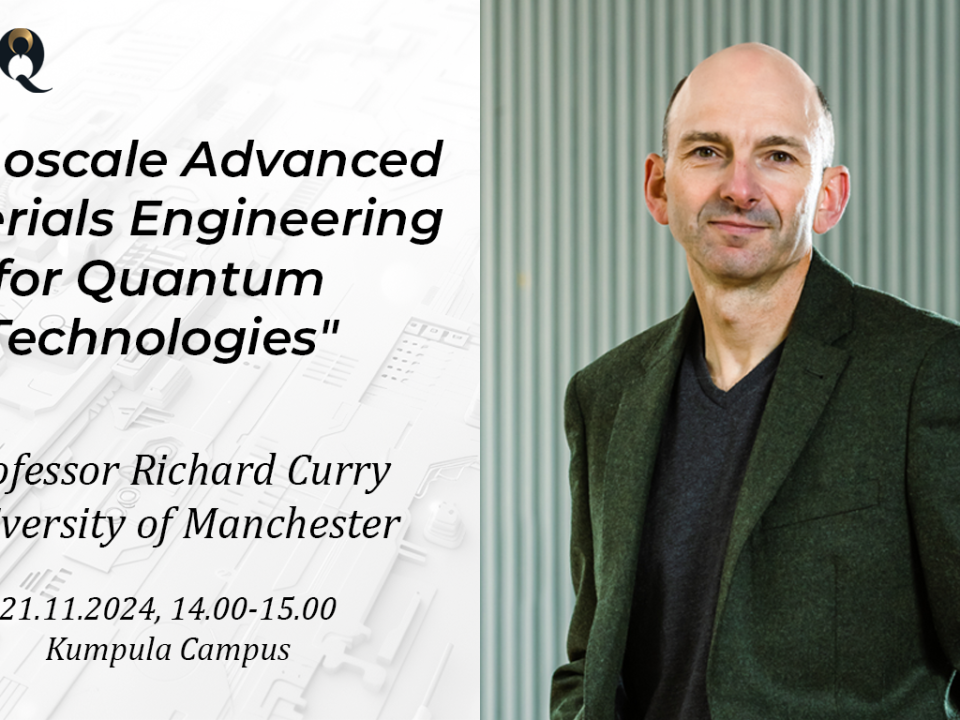

InstituteQ Colloquium: Dr. Andres Castellanos-Gomez from the Spanish National Research Council (CSIC)
This InstituteQ Colloquium features Dr. Andres Castellanos-Gomez. The title of his talk is "2D straintronic adaptable photodetectors and transistors."
When: 14:00-15:00, 25.04.2024
Where: Hall B, Otakaari 1, Aalto University
Chair: Assistant Professor Jose Lado, Aalto University Department of Applied Physics
The event is free to attend for all, and refreshments will be served. Please sign up via the Webropol registration form.
Please note that the event is on-site only and will not be recorded.
Guest speaker
Dr. Andres Castellanos-Gomez is a Tenured Scientist in the Spanish National Research Council (Consejo Superior de Investigaciones Científicas, CSIC). He explores novel 2D materials and studies their mechanical, electrical and optical properties with special interest on the application of these materials in nanomechanical and optoelectronic devices.He is author of more than 150 articles in international peer review journals and 6 book chapters. He was awarded an ERC Starting Grant in 2017 and has been appointed Fellow of the International Association of Advanced Materials (IAAM) in 2020, has been included in the Emerging Leaders 2020 special issue of the Journal of Physics: Materials, included in the Highly Cited Researchers 2018, 2019, 2020 and 2021 lists of Clarivate/WOS, selected as one of the 2018 Emerging Investigators by Chemical Society Reviews and selected as one of the Top Ten Spanish Talents of 2017 by the MIT Technology Reviews. He has been also recognized with the Young Researcher Award (experimental physics) of the Royal Physical Society of Spain (2016).
From Andres Castellanos-Gomez: What is your talk about?
"Strain engineering is an interesting strategy to tune a material’s electronic properties by subjecting its lattice to a mechanical deformation. Conventional straining approaches, used for 3D materials (including epitaxial growth on a substrate with a lattice parameter mismatch, the use of a dielectric capping layer or heavy ions implantation) are typically limited to strains lower than 2% in most cases due to the low maximum strains sustained by brittle bulk semiconducting materials. Bulk silicon, for example, can be strained only up to 1.5% before breaking. Moreover, these straining approaches induce static deformations of the semiconductor materials and therefore they are not suitable for tunable functional devices. 2D materials can be literally stretched, folded, bent or even pierced. [1] This outstanding stretchability (and the possibility of using dynamically varying strain) of 2D materials promises to revolutionize the field of strain engineering and could lead to "straintronic" devices – devices with electronic and optical properties that are engineered through the introduction of mechanical deformations."In this talk I will discuss our recent efforts to study strain engineering in 2D materials and to exploit it to fabricate strain tunable functional optoelectronic devices. [2-10]."
References:
[1] R Roldán et al. Journal of Physics: Condensed Matter (2015) 27 (31), 313201
[2] A Castellanos-Gomez, et al. Nano letters (2013) 13 (11), 5361-5366
[3] J Quereda, et al. Nano letters (2016) 16 (5), 2931-2937
[4] JO Island, et al. Nanoscale (2016) 8 (5), 2589-2593
[5] R Schmidt et al. 2D Materials (2016) 3 (2), 021011
[6] R Frisenda, et al. npj 2D Materials and Applications (2017) 1 (1), 10
[7] P Gant, et al. Materials Today (2019)
[8] Ryu YK, Carrascoso F, López-Nebreda R, Agraït N, Frisenda R, Castellanos-Gomez A. Microheater actuators as a versatile platform for strain engineering in 2D materials. Nano Letters. 2020 Jun 3;20(7):5339-45.
[9] Çakıroğlu O, Island JO, Xie Y, Frisenda R, Castellanos‐Gomez A. An automated system for strain engineering and straintronics of 2D materials. Advanced Materials Technologies. 2023 Jan;8(1):2201091.
[10] Carrascoso, Felix, Hao Li, Jose M. Obrero-Perez, Francisco J. Aparicio, Ana Borras, Joshua O. Island, Angel Barranco, and Andres Castellanos-Gomez. "Improved strain engineering of 2D materials by adamantane plasma polymer encapsulation." npj 2D Materials and Applications 7, no. 1 (2023): 24.
Related posts
08/10/2024



